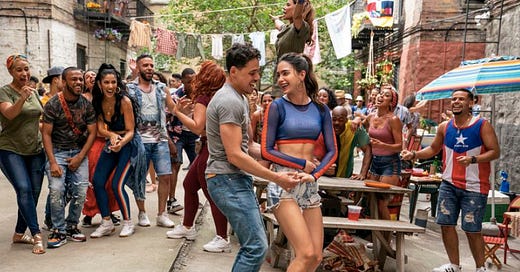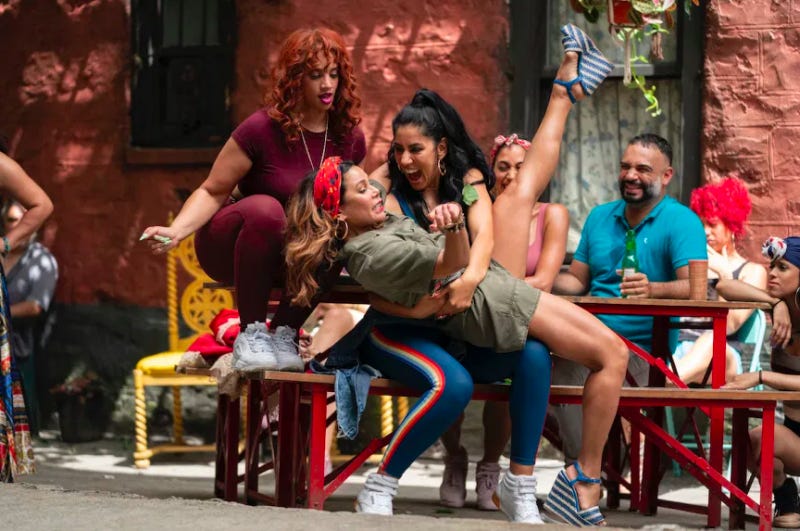In The Heights
Any flaws with "In The Heights" are owed to the original source material and not director Jon M. Chu, who has made one of the best movie-musicals ever. It's the feel-good movie of the summer.
I’m going to make two bold statements about “In The Heights,” the new movie adapted from 2005 stage musical by Lin-Manuel Miranda.
First: This is the best musical-movie since the Best Picture-winner “Chicago” in 2002. In fact, I personally like “In The Heights” better and it might go down as one of the best musical-movies ever made.
Second: This is the movie we needed in the summer of 2021. It’s a beautifully shot film full of joy and community celebration. After a year of being isolated in our homes, to see people on the screen who are singing, dancing and connecting to one in another — in the streets — is what we needed. It’s a cathartic release after all we’ve all been through.
Director Jon M. Chu, who previously helmed “Crazy Rich Asians,” has called this new movie, “a vaccine for the soul.” He’s not wrong.
Life is back. It’s time to dance.
In this new movie, you can see the seeds of “Hamilton,” the acclaimed Broadway musical that Miranda wrote and starred in while waiting for the movie version of “In The Heights” to finally get made (the rights were purchased in 2008 but Universal Pictures said they couldn’t find a “bankable Latino star” to warrant the production budget).
And yes, “In The Heights” is less sophisticated than “Hamilton” in both story structure and songwriting, but it has a lot of heart. It’s not trying to tell a sweeping story of the founding of our nation, but rather a smaller, more relatable tale of young people finding their place in the world. People celebrating their culture and fighting against prejudice. A neighborhood being washed away by gentrification. And, overall, a story about everyone chasing their sueñito, i.e., their “little dream.”
The movie starts off with Usnavi (Anthony Ramos) rapping about every day life in Washington Heights, the mostly Hispanic neighborhood on the upper west side of Manhattan, far from where tourists frequent. With a megawatt smile on his face, Usnavi introduces us to the familiar faces who regularly pop into his bodega for a café con leche and a lottery ticket, hoping for a brighter future if the right numbers are called.
There’s Kevin Rosario (Jimmy Smits, who seems to never age) who owns the taxi-cab/car service and pins all of his hopes and dreams on his daughter Nina (Leslie Grace), a freshman at Stanford. There’s Usnavi’s best friend Benny (Corey Hawkins), an African American who works at Rosario’s shop and pines after the boss’s daughter. There’s Abuela (Olga Merediz, from the original Broadway cast) who acts as a surrogate grandmother to every parentless young person on the block. And there’s Vanessa (Melissa Barrera), the flirtatious artist who dreams of getting an apartment in downtown Manhattan.
Usnavi, the narrator of this story, dreams of returning to his homeland of the Dominican Republic and rebuilding the beachside bar that his father owned. There’s only one problem: that means bailing on the budding romance between himself and Vanessa, just as their relationship moves from smiles and glances into an actual official date.
There are small cameos from Lin-Manuel Miranda and Christopher Jackson, who both starred in the original Broadway cast of both “In The Heights” and “Hamilton.” Both have aged out of their respective roles as Usnavi and Benny but it’s nice to see them as the Piragua Guy and Mr. Softee, dueling dessert salesmen.
Daphne Rubin-Vega, from the original Broadway cast of “Rent,” has a small role as salon owner, backed up by Stephanie Beatriz of “Brooklyn Nine-Nine” and Dascha Polanco of “Orange is the New Black.” She does get her own song though.
Marc Anthony plays a tatted-up alcoholic father in a one-scene role. His character doesn’t sing but Anthony is featured in an original new song that plays over the credits.
Movie-goers can feel the heat from the screen as the summer temperatures keep rising, reminiscent of Spike Lee’s “Do The Right Thing.” It all culminates in a neighborhood power blackout that shows how “powerless” our protagonists feel in their lives.
I know it’s cliche to say that “the setting is like another character” but it’s quite true in this movie. In one scene, Nina, who longs to stay in her neighborhood and not return to college, closes her eyes and just “listens to her street.” Kids splashing in an opened fire hydrant. Bicycle bells ringing. Cars honking. The sounds of summer days.
So many of us might live in neighborhoods where we don’t even know our neighbors’ names. We wave to them as we get the mail but that’s about it. This movie shows us how powerful it is to be connected to where you live.
Usnavi begins the movie by saying the “streets were made of music” and the movie fulfills that promise. Shot on location in the actual Washington Heights, Chu is able bring to life what audiences had to imagine with 2D backgrounds in the Broadway production.
Probably the most elaborate set piece in the entire two-hour-plus movie comes during the song “96,000.” Each character raps or sings about what they would do if they won the lottery and the location moves to the Highbridge Pool, one of the oldest pools in New York City built along the Harlem River in 1936. More than 500 extras are used for a candy-colored, high-energy dance number that is a true show stopper. (If you’re watching on HBO MAX, you’ll want to hit rewind and watch that scene again immediately!)
Chu is also able to slow things down and make the big city feel intimate, especially during a romantic duet between Benny and Nina called “When the Sun Goes Down.” Hawkins croons in his smooth voice as they walk along skyscrapers like they were Spider-Man. It’s an inventive use of special effects that’s every bit as impressive as any of the scenes in “La La Land.”
Chu got his start directing music videos and broke into feature films with the “Step Up” sequels. He’s able to draw from the best of his music video past while still injecting heart and humanity into the characters, the costumes and the backdrops.
Where the movie starts to falter might be in his paper-thin story line. Some characters are developed better than others. Even at more than two hours, lyrics and songs had to be cut from the original Broadway show. A side plot about Dreamers and DACA was added for the film version to make it more contemporary and it works quite well. Instances of looting during the blackout are removed to sidestep that political debate (probably a good idea). And a storyline about Nina’s father being hesitant about her dating a black man is omitted. I understand why you wouldn’t want to add that storyline (especially if you were just going to rush it) but it’s removal left Benny and Nina with an underdeveloped relationship without much drama.
While I understand these changes, the end result is a story without much conflict. Maybe that’s by design. Miranda said when he was workshopping the original musical in 2005 that people told him that he needed to add an unexpected pregnancy or a conflict with gangs. He said the idea of finding out who you are is drama enough. If he couldn’t make that resonate with people then he didn’t do his job.
I’ll admit that not every song packs the same voltage. Unlike “Hamilton,” I wasn’t entranced from start to finish. But just when I started to get antsy and check my watch, the movie kicked back into gear and ends with a bang. You’ll walk out of the movie theater with a gigantic smile on your face, feeling like you can conquer the world.
I wavered between giving this movie 4.5 stars and 5 because the film isn’t perfect. But I ended up with the higher score because when this movie succeeds, it soars. Some of my favorite movies ever made aren’t flawless.
Most of the very few problems with this movie can be pinned on the original source material, not the cast or director.
When I say that is the movie we need right now, it’s not just because it’s an incredibly positive movie. It’s also because it tells an important story of community belonging and taking pride in your heritage.
Hispanic immigrants who have come to this country don’t always feel the open arms of everyone. Prejudice still exists, as shown in a tearful speech by Nina who recounts getting falsely accused of stealing her college roommate’s necklace.
While the movie admits that racism and economic struggle persist in our nation, it never uses it as an excuse to give up. These characters — strengthened by their community bonds — keep on dancing and keep on fighting.












